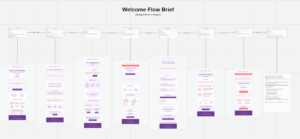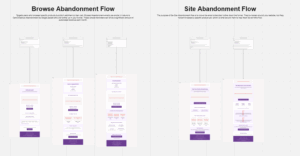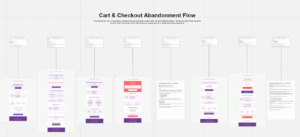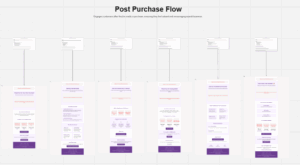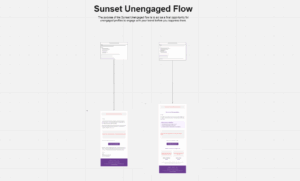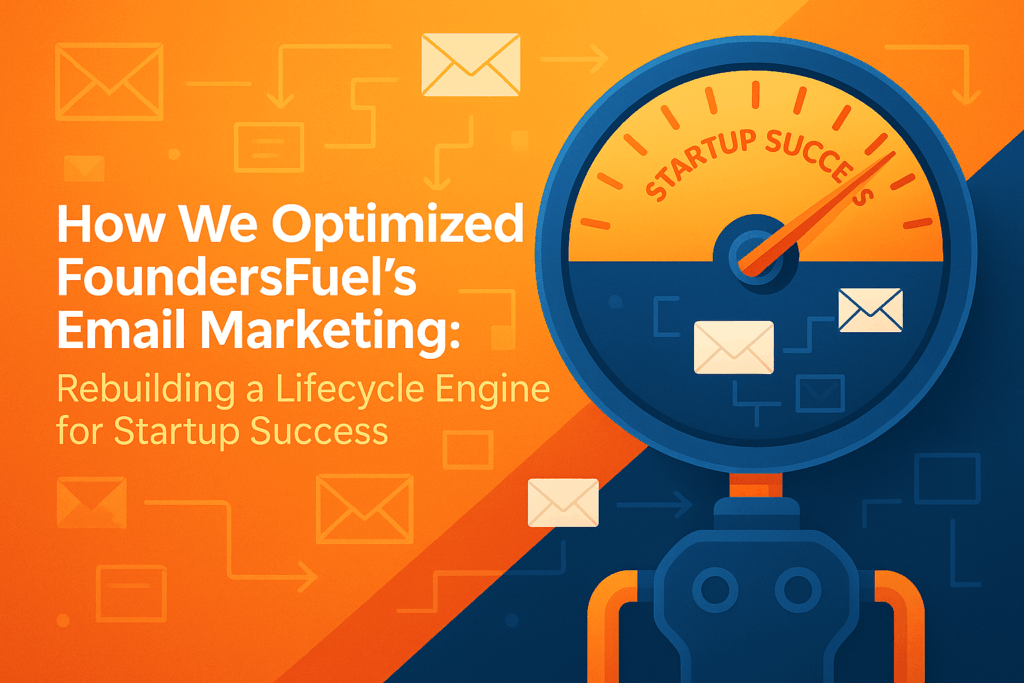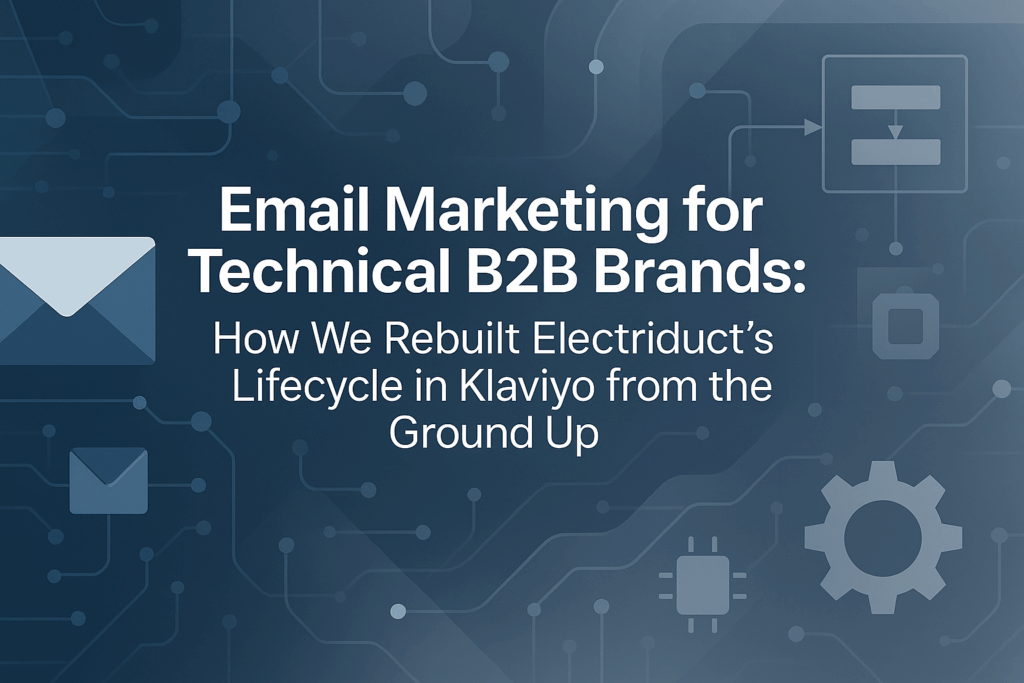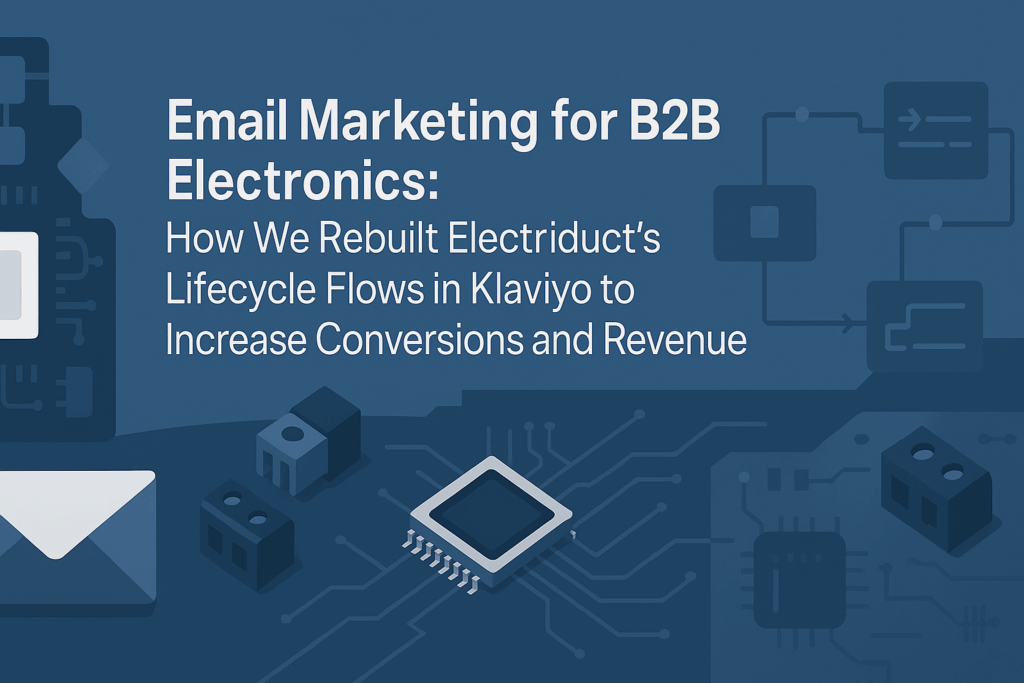When World-Class Products Outgrow a Basic Email Strategy
Vyper Industrial didn’t rise through clever marketing or big-box placement. It earned its place the old-fashioned way—through grit, craftsmanship, and gear that doesn’t quit. Founded by brothers Dayne and Dylan Rusch, two hands-on builders who grew up turning wrenches in their family garage, Vyper makes premium American-made chairs, creepers, carts, and fans for people who actually use them: welders, mechanics, DIYers, and shop professionals who expect tools to outlast the job.
The brand speaks for itself. Legends like Jay Leno and Chip Foose praise their builds. Their customers stick around for years, not months. Everything about Vyper screams durability, pride, and purpose.
Except for their email marketing.
Despite a loyal, tool-obsessed audience and a product line that practically sells itself on reputation alone, Vyper’s Klaviyo setup wasn’t holding its weight. The automations were broken. The voice was off. The revenue potential? Largely untapped. Their email flows felt like an afterthought, generic, disconnected, and nowhere near the level of quality their audience had come to expect.
That’s where we came in.
Our goal wasn’t to send better campaigns. It was to rebuild their entire lifecycle system from scratch, one that didn’t just reflect the Vyper brand, but amplified it. We mapped out a 7-flow structure with 34 fully written, strategically timed emails. Each one was built to do a job: welcome, convert, recover carts, re-engage lapsed buyers, and turn first-time customers into lifelong advocates.
We didn’t create marketing fluff. It was a system designed to drive revenue with the same kind of no-compromise attitude that built Vyper in the first place.
Welcome Flow Strategy: Telling the Story That Makes Customers Believe
When someone joins Vyper’s list, they’re not just browsing, they’re sizing up. Maybe they’ve heard about the chairs from a friend. Maybe they saw a creeper featured in a Jay Leno video. Either way, they’re not here for gimmicks. They’re here to see if this gear can go the distance. And before they buy, they want to know who’s behind it, what makes it different, and whether it’ll hold up in the garage.
That’s why this welcome flow wasn’t a sequence of nudges. It was a statement. A full-bodied introduction to the values, vision, and backbone behind the tools.
Start with Confidence, Not Pressure
The first message didn’t shout. It showed. We opened with a clean, grounded introduction to the brand—Made in America, built for people who work with their hands, and trusted by legends who do the same. The discount? There if you wanted it, but tucked beneath the fold. Up top, we featured a product lineup designed to earn a second glance, not chase one. This email gave people what they came for: clarity, pride, and a reason to look deeper.
From the Garage to the World
Next, we brought them into the garage. Real photos. Early prototypes. The kind of origin story that doesn’t start with a marketing deck, it starts with two brothers and a need no one else was solving. The Rusch story wasn’t polished; it was personal. And in an industry that’s full of copycats and white-labeled gear, that honesty hit hard. People didn’t just meet a brand. They met builders.
Tools Built to Earn Respect
Then we got into the details. What separates Vyper from cheaper options isn’t just the design, it’s the materials, the craftsmanship, and the hard-earned wisdom of people who know what long days on concrete feel like. This email was built to educate without overselling. Every paragraph had a purpose. Every feature had a user story behind it. And every claim was backed by something real.
Proof from the Pros
To earn trust, we brought in others. Not influencers. Mechanics. Builders. Garage owners who swear by the gear and put it through hell. Their stories didn’t sound like reviews—they sounded like conversations. One testimonial came from someone who swapped out his entire setup after a single use. Another from a shop manager who said, “Finally, something I don’t have to replace next year.” This wasn’t social proof for the algorithm. It was proof for the buyer.
Last Chance, But Not a Push
The final note came from the founders. No urgency tricks. No countdown timers. Just a reminder: if you’re ready, we’d love to have you. And if you’re not? We’re still here when you are. The tone was grounded. The message is clear. This wasn’t about closing the loop. It was about keeping the door open on Vyper’s terms.
Why This Flow Works
Vyper customers don’t buy on impulse. They buy when they feel understood. This flow didn’t treat them like a lead—it treated them like part of a community built on the same values: grit, craft, and zero shortcuts. It was educated first. It respected their time. And when the offer arrived, it wasn’t a sales tactic. It was a thank you.
Abandonment Flows: Re-Engaging Tool Buyers Who Think Before They Click
Vyper’s audience isn’t casually browsing. These are seasoned mechanics, welders, and DIY pros who don’t grab tools on impulse — they weigh, compare, and analyze. Abandonment doesn’t mean disinterest. It means the decision is still in motion. So we didn’t chase them with discounts. We gave them real reasons to return.
Site Abandonment Flow (2 Emails)
Still Building Out Your Shop?
The first message opened softly — a question, not a pitch: “Did your shop needs get sidetracked?” We presented key product categories like chairs, creepers, and industrial fans, each framed with a short description tailored to how real garages use them. No aggressive CTAs. Just a way to re-orient the visitor and let them pick up where they left off, without pressure.
Tools for How You Actually Work
In the second message, we shifted from category reminders to tailored product showcases. This time, we emphasized relevance — how each featured product performs in context. A creeper that reduces shoulder fatigue on long jobs. A cart that holds up to welding sparks and workshop grime. Paired with quotes from real users, this email wasn’t a catalog. It was a prompt to revisit gear built for the buyer’s actual workday.
Browse Abandonment Flow (3 Emails)
Take a Closer Look
If someone spent time on a specific product page, we followed up with a focused reintroduction. The product image took center stage, followed by a benefits-first breakdown: build quality, comfort under pressure, and the materials behind the longevity. Instead of pushing for the sale, we offered a second look with one goal — give the buyer more confidence in their gut instinct.
What Others Say After 200 Hours of Use
By now, the product had a spot in their mental shortlist — but they needed validation. We delivered that with testimonials pulled straight from Vyper’s reviews: shop owners, mechanics, and weekend builders explaining what changed in their workflow after switching. These weren’t marketing scripts. They were real experiences: “Back pain gone after long days,” “Still rolling smooth six months in.” The email added credibility exactly when doubt usually creeps in.
Need a Final Push (or Just Some Clarity)?
In the last message, we gave space to resolve lingering questions. A short, honest FAQ addressed what usually holds buyers back: return policies, warranty terms, compatibility. And instead of a last-minute discount, we offered a time-limited upgrade — an extended warranty or free accessory — framed as added value, not bait. It was a final, respectful tap on the shoulder: “Still thinking about it? We’ve got you covered.”
Why This Flow Works
This flow respects the mindset of serious buyers. There’s no pressure, just precision. We treat every click as the start of a considered decision, not a missed opportunity. Each message is built to inform, reassure, and reflect how this audience actually makes purchases — through trust, evidence, and time.
Cart & Checkout Flow Optimization
Abandoning a cart doesn’t always mean saying no. Especially not when the product is something like a Vyper creeper or mechanic’s chair — gear that’s meant to last years, not months. For these buyers, cart abandonment often means they’re just thinking things through. Our job wasn’t to push them. It was to reassure them.
So we built a full 8-part flow designed to restore confidence, not apply pressure. Every message served one purpose: to remind them why they clicked in the first place — and to show them that this wasn’t just another tool purchase. It was an upgrade to how they work.
The Gentle Reminder
We opened with a clean, no-nonsense message: your cart is still here, and so is the gear you picked. The email featured a hero shot of the exact item they left behind, followed by key specs — load rating, frame construction, padding thickness. No urgency. Just: “You left something worth owning.”
Why Builders Choose Vyper
Next, we leaned into proof. A quote from a full-time mechanic: “This thing’s still smooth after a year of daily use.” We broke down what makes the build different: tig-welded frames, powder-coated durability, American steel. No fluff. Just real performance, told by people who actually use the gear.
The Garage Behind the Brand
Here, we zoomed out to show where the product comes from — not a factory line, but a workshop run by the Rusch brothers. We told the story of how Vyper started in a garage, showed behind-the-scenes photos, and added a quote from Dayne about why they design every product to outlast anything in its class.
Built to Work Together
Instead of repeating the pitch, we shifted to helpfulness. “Still thinking about that creeper? Here’s what works great with it.” Then we showed their tool carts, utility stools, and fans — each with a one-liner about how it adds value to a complete garage setup. No upsell language. Just utility.
What Happens After You Order
To remove hesitation, we gave a quick look behind the shipping table. We showed how orders are inspected, packed, and shipped — plus clear notes on delivery times, returns, and how to reach support if needed. It said: we’ve got your back, before and after the sale.
What Real Users Are Saying
We closed the gap between curiosity and conviction by letting customers do the talking. One story from a retired welder. One from a mobile mechanic. One from a hobbyist restoring his first car. Each story added a different reason to believe — and a quiet reminder: you’re not the only one who saw the difference.
Your Spot’s Still Saved
By this point, we knew the buyer had seen it all. So we added a soft boundary: “We’ll keep this cart active for 3 more days.” No countdown clocks. No flashing timers. Just a simple, respectful signal that we’re here, but we won’t chase them forever.
A Note From the Founders
The final message was from Dylan and Dayne — in plain text, signed with their names. It said: “If you’re still deciding, or have a question, we’re right here. No pressure. We just want to make sure the gear you choose is the right fit.” There was no link. Just a reply button. And that was the point.
Why This Flow Works
Every part of this cart sequence is designed for the way pros buy. Not fast, not impulsively — but deliberately. Instead of sales tricks, we gave them reasons. We answered their questions before they had to ask. We made the brand feel human, and the gear feel like a step forward in their work. And we ended with trust, not pressure.
Post-Purchase Flow: Extend the Experience, Deepen the Loyalty
The sale isn’t the finish line—it’s the starting line for trust.
That’s how we approached Vyper’s post-purchase journey. Once a customer hits “Buy,” they’re emotionally invested. Our job was to meet that moment with clarity, gratitude, and momentum. This sequence wasn’t just about reducing support tickets—it was about reinforcing pride in their purchase, answering unspoken questions, and keeping the connection alive long after checkout.
The Setup for Success
The first email arrived with the shipping confirmation—but it didn’t stop there. We included a clean setup guide, formatted for mobile-first reading in the garage. The copy was crisp and mechanical in tone—just like the product. This wasn’t filler. It was a handshake.
Tips from the Pros
Next, we shared usage tips straight from the shop floor. Short, punchy suggestions from real Vyper owners: how to adjust for long-shift comfort, where to store attachments, how to clean without wear. It felt more like advice passed down than marketing pushed out.
Still Good? Let Us Know
A few days in, we checked in—not to upsell, but to make sure everything felt right. “Is your creeper rolling smooth? Stool holding up through long shifts?” We kept it brief and invited replies, not clicks.
Proud Owners, Featured Loud
Mid-sequence, we invited them to share a photo of their setup. And when they did? We featured those builds. The tone wasn’t “show off.” It was “join the crew.” Every image made the brand feel less like a company, more like a community.
One More Add-On That Makes Sense
Once confidence was built, we suggested a complementary product—only one. Selected based on what they’d bought. No pressure, no bundle pushes. Just a logical “while you’re at it.”
Got a Sec? Help Someone Decide
We ended the flow with a soft ask for a product review, paired with a kind nudge: “Your review helps builders like you find what works.” And for those who loved what they got, we added a referral code—quietly.
Why This Flow Works
Most brands stop talking once the box ships. We didn’t. For a company like Vyper, post-purchase isn’t a loose end—it’s part of the product promise. Every email in this flow was built to extend the experience, not just follow up. From setup guides to review requests, each message gave the customer one more reason to feel confident in their purchase—and proud of the brand behind it. No fluff. No fake urgency. Just timely, useful touchpoints that feel like an extension of the product itself. That’s what builds trust after the sale.
Winback Flow: Progress Over Pressure
When someone hadn’t been back in a while, we didn’t beg. We built a bridge.
This winback sequence wasn’t about discounts. It was about reigniting momentum—reminding past customers of the tools they trust and offering a look at what’s next in the shop. Every message was designed to pick up where the relationship left off, not pretend it never happened.
What’s New in the Shop?
We opened with a subtle reintroduction: a simple update on new gear in the Vyper lineup, selected based on what they’d bought before. If someone had ordered a creeper, we showed them the latest stool. If they grabbed a cart, we teased the new utility trays. It wasn’t a catalog—it was a curated pulse check.
A Fresh Drop Worth a Look
Next, we spotlighted a new product release. The layout was clean and direct. Just the essentials: a hero shot, a short description, and a quote from someone who had already put it to work. The tone was more “check this out” than “buy now.”
The Garage Wall of Fame
Midway through the flow, we shifted to community. This email was packed with photos from real workshops—mechanics, welders, DIYers—each using their Vyper gear in the wild. The email didn’t pitch a thing. It just said, “Look what people like you are building.”
Something Extra for the Loyal Few
Later, we offered early access to an upcoming product release. No promo code, no flashy banner—just a heads-up that our most loyal customers could reserve their spot before the public drop. It felt more like being in the know than being sold to.
From the Founders’ Inbox
To close it out, Dayne and Dylan sent a plain-text note. No graphics, no buttons—just a short message asking, “Still building?” and offering help if they were. The tone was friendly, humble, and real.
Why This Flow Works
This wasn’t a hail-mary discount play. It was a reminder of why they bought in the first place. Instead of “we miss you,” we showed what’s new, what’s useful, and what’s worth returning for. It worked because it respected the customer’s timeline while reigniting the belief that led them to Vyper to begin with. No gimmicks—just relevance, story, and momentum.
Sunset Flow: Exit With Integrity
Not everyone sticks around—and that’s okay. Our sunset flow respected that, without groveling or guilt.
This two-touch sequence was quiet and intentional, offering a last chance to re-engage without compromising the brand’s values. Because even your unsubscribe strategy should reflect your craftsmanship.
Are We Still Welcome in Your Inbox?
The first message opened with a simple, honest question: “Are we still a fit?” No hard sell, no dramatics. Just a reminder that we hadn’t seen them in a while and an easy option to stay or unsubscribe. The tone? Direct and respectful—like a conversation between equals.
One Last Nudge, No Pressure
The second and final email came with a soft surprise: free shipping for the next 72 hours. No timers. No countdown clocks. Just a brief reminder of what they once loved about the brand, paired with one small gesture in case they were still on the fence.
If they didn’t click, we let them go.
Because great brands don’t need to chase. They just need to know when to step back.
Why This Flow Works
When someone goes quiet, pushing harder doesn’t help. This flow gave space, not pressure. It opened with a simple check-in, then offered one last chance to stay in the loop—without bait or urgency. Even list cleanup reflected Vyper’s values: clear, respectful, and honest. It’s not about chasing disengaged subscribers. It’s about making sure those who remain actually want to be there.
Strategy: Rebuilding the System from the Ground Up
Vyper didn’t just need better emails—they needed a structure that matched their product quality. What they had was fragmented: a few generic flows, weak automation, no emotional arc. It felt like a template. And for a brand built on grit, legacy, and performance, that disconnect was costing them.
So we started from zero. Not with campaigns or quick wins—but with the architecture. A complete Klaviyo rebuild. Seven flows. Thirty-four handcrafted emails. Every sequence mapped to a specific moment in the buyer journey, every line of copy tuned to the mindset of a builder, mechanic, or pro who buys with purpose.
The goal wasn’t volume. It was cohesion. A system that felt deliberate, from the first welcome touch to the last post-purchase email. Something that didn’t just convert—but felt like it came from Vyper. We weren’t here to write marketing emails. We were here to build a lifecycle that worked as hard as the product itself.
What Other Tool Brands Can Learn From This
Vyper’s story isn’t just about one brand finding its voice again. It’s a reminder of what happens when a DTC business treats email not like a megaphone—but like a workshop.
If you sell tools, equipment, or any product where performance is personal, this isn’t just a case study. It’s a blueprint. Here’s what we’d want any founder, CMO, or ecommerce team to take away:
Lead With Your Values, Not Just Your Features
Vyper’s welcome journey didn’t start with a discount. It started with a story—of two brothers, a garage, and the grit it takes to build something that lasts. In an industry where everyone claims durability, what cuts through is authenticity. You’re not just selling products. You’re earning belief.
Write for Real Emotions, Not Email Types
When we built this system, we didn’t start by checking off flow names. We started by asking, “What’s this customer feeling right now?” Curiosity. Hesitation. Doubt. Pride. Every email met those emotions head-on—with clarity and calm.
Design With Intention, Not Just Aesthetic
Inbox design isn’t decoration. It’s a strategic layer of your brand experience. Layouts were stripped down, purposeful. CTAs were shaped by intent, not color trends. Icons, photos, button placement—it all told a story even before a word was read.
Think Systems, Not One-Offs
Campaigns get attention. Flows build equity. They sit quietly in the background, doing the heavy lifting. Done right, they’ll outperform every other retention channel you have—and require far less babysitting once they’re built.
Don’t Just Launch—Maintain
The real gains show up when the system is nurtured. Better deliverability. Tighter segmentation. Consistent testing. Email isn’t a project. It’s a compounding asset, and the more care it gets, the harder it works.
What We Expect to Happen
While the system hadn’t been live long enough to report definitive data, we weren’t guessing. We’ve rebuilt email infrastructures like this for premium DTC brands in adjacent verticals—and the performance upside has followed a clear pattern.
- Open rates were expected to rise from the 12–18% range to a more consistent 25–30%, powered by intentional subject lines, brand-aligned sender names, and smarter segmentation.
- Click-through rates were projected to double, increasing from around 1.5–2% to 4–5% by delivering more relevant flows, deeper product education, and well-placed CTAs.
- Cart and abandonment flows were built to convert at 2x their previous pace—especially once layered with AOV-friendly incentives, objection handling, and personalized reminders.
- Welcome flow performance was expected to push subscriber-to-customer conversions from 10–15% up to 40–60%, as the new sequence better aligned with buyer psychology and product consideration timelines.
- Repeat purchases were projected to climb 25–40% within 90 days, driven by post-purchase engagement and winback journeys that felt like support, not sales.
- Sunset flows were estimated to re-engage or cleanly remove 20–30% of previously inactive subscribers—leaving a leaner, higher-performing list behind.
But beyond the projections, the system was designed for something harder to measure: customer confidence. Every touchpoint was there to reinforce the value Vyper had already built—not to close harder, but to convert smarter.
If you’re ready to build an email system that works as hard as your brand does, contact us, we’ll design it, write it, and engineer it to perform.




